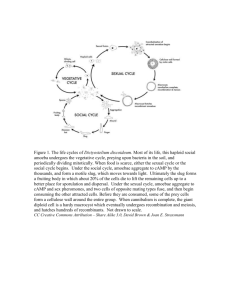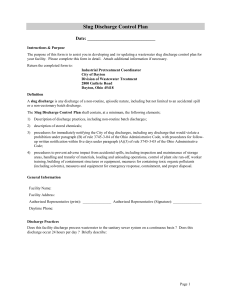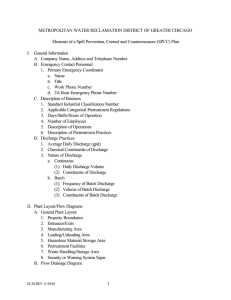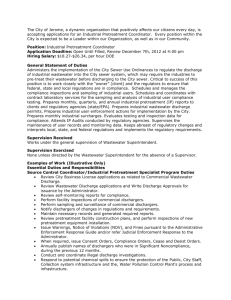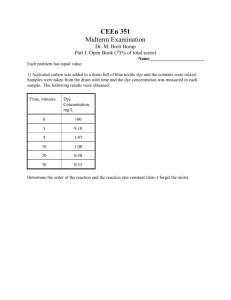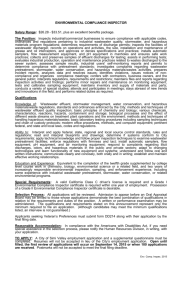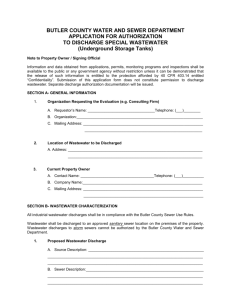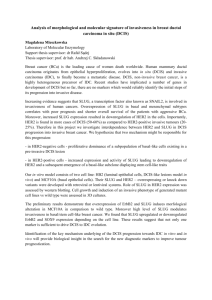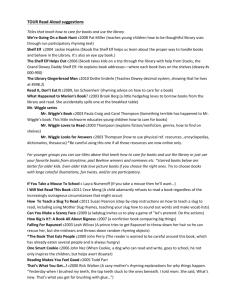SPILL/SLUG DISCHARGE CONTROL PLAN
advertisement
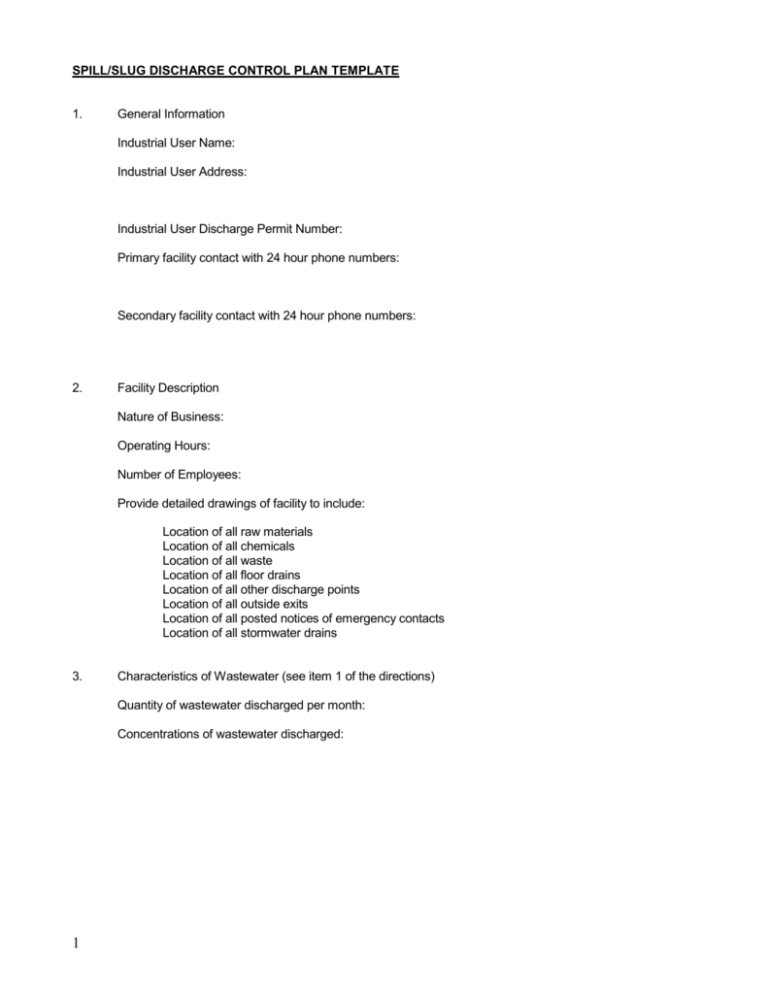
SPILL/SLUG DISCHARGE CONTROL PLAN TEMPLATE 1. General Information Industrial User Name: Industrial User Address: Industrial User Discharge Permit Number: Primary facility contact with 24 hour phone numbers: Secondary facility contact with 24 hour phone numbers: 2. Facility Description Nature of Business: Operating Hours: Number of Employees: Provide detailed drawings of facility to include: Location of all raw materials Location of all chemicals Location of all waste Location of all floor drains Location of all other discharge points Location of all outside exits Location of all posted notices of emergency contacts Location of all stormwater drains 3. Characteristics of Wastewater (see item 1 of the directions) Quantity of wastewater discharged per month: Concentrations of wastewater discharged: 1 4. Characteristics of Raw Materials Inventory of all raw materials (see separate page) Inventory of all chemicals (see separate page) Inventory of all waste (see separate page) 5. Spill/Slug Control Type of containment used for all chemicals, raw materials, and waste: Do you have warning devices prior to any slug releases? Yes No Yes No If yes, describe 6. Do you have emergency response equipment available? If yes, describe 7. Notification of Slug Discharge In the event of a slug release: Do you have a procedure to immediately notify Broward County’s Industrial Pretreatment Program at ______________? Yes No Do you have notices posted of appropriate contact persons with phone numbers? Yes No If yes, please attach copy. 8. The wastewater is discharged to the following Wastewater Treatment Facility: ____________________________________________________________ 2 9. Provide a synopsis of your training program dealing with spill/slug control. I certify under penalty of law that this document and all attachments were prepared under my direction or supervision in accordance with a system designed to assure that qualified personnel properly gather and evaluate the information submitted. Based on my inquiry of the person or persons who manage the system, or those persons directly responsible for gathering the information, the information is, to the best of my knowledge and belief, true, accurate, and complete. I am aware that there are significant penalties for submitting false information, including the possibility of fine and imprisonment for known violations. I also understand that applicable civil and criminal penalties may apply for any violations of pretreatment standards, requirements and/or compliance schedules. ____________________________ Name & Title of Representative: ____________________________ Signature of Representative: _____________________ Date of Signature: 3 RAW MATERIALS 4 LOCATION CHEMICAL 5 LOCATION TYPE OF WASTE 6 LOCATION Directions for Completing Spill/Slug Control Plan 1. To assist you in completing the Plan, the following is a list of classes of pollutants that may result in slug loadings. Biological Wastes (e.g., whey solids or antibiotics) Chemical Feedstocks (e.g., nitrobenzene, aniline, phenol, cumene phthalic anhydride, cyclohexane, etc.) Corrosives: Strong Acids (e.g., hydrochloric acid, sulfuric acid, nitric acid, chromic acid, etc.) Strong Bases (e.g., caustic soda, lye, ammonia, etc.) Detergents Explosive Chemicals (e.g., TNT, nitroglycerin, metallic sodium, ammonium nitrate, picric acid, lead azide, etc.) Flammable Chemicals (e.g., phosphorous pentasulfide, acetone, naphtha, methyl, isobutyl ketone, sodium sulfide, hexane, cyclohexane, etc.) Halogenated Solvents (e.g., freon, perchloroethylene, trichloroethane, etc.) Metal Sludges (e.g., metal hydroxide sludges from pretreatment operations) Nonhalogenated Solvents (e.g., alcohols, methyl ethyl ketone, benzene, etc.) Noxious/Fuming Chemicals (e.g., phosphorous pentachloride or oxychloride, hydrofluoric acid, cyanide, chloroform, etc.) Oils and Fuels (e.g., diesel oil, bunker fuel oil, gasoline, cottonseed oil, linseed oil, etc.) Oxidants (e.g., chlorine dioxide, phosphorous pentoxide, potassium permanganate, sodium chlorate, etc.) Paints, Pigments, Dyes, Inks and Thinners Pesticides Plating Baths and Pickling Liquors Radioactive Materials Reductants (e.g., sodium borohydride, phosphine, methyl hydrazine, etc.) Resins (e.g., ABS resins, phenolic resins, vinyl resins, etc.) Tars, Creosotes, and Pitch Varnishes, Lacquers, and Waxes 2. 7 For purposes of reporting a slug release to the Broward County Industrial Pretreatment Program. The following guidelines should be used. 10 lbs or more heavy metals (including arsenic, cadmium, chromium, copper, lead, mercury, nickel, silver, zinc, cyanide) in solution. 1 gallon or more of any toxic organic substances listed in the Ordinance (which includes 46 base/neutral extractables, 10 acid extractables, 28 volatile organics and 25 pesticides) All flammable liquids above one gallon Any other liquid material determined to have adverse effects on the sewerage system and wastewater treatment plants (including alkalis or alkaline substances, oils, foam generating wastes, highly colored wastes, pesticides and solvents not listed previously.) 3. Complete spill/slug control discharge plan as directed by the form. PLEASE NOTE: Your procedure for immediately notifying the control authority i.e. the Industrial Pretreatment Program and the Wastewater Treatment Facility of slug discharges, including any discharge that would violate a prohibition under Rule 62-625.400(2), F.A.C., should include follow-up written notification within five days and if necessary, procedures to prevent adverse impact from accidental spills, including inspection and maintenance of storage areas, handling and transfer of materials, loading and unloading operations, control of plant site run-off, worker training, building of containment structures or equipment, ,measures for containing toxic organics (including solvents), or measures and equipment for emergency response. 8
